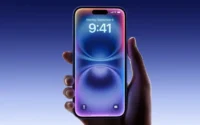iPhone 16 vs. iPhone 15: Is It Worth the Upgrade?
Apple’s iPhone series continues to push the boundaries of mobile technology, and with the anticipated release of the iPhone 16, many are wondering: Is it worth upgrading from the iPhone 15? In this detailed comparison, we’ll explore the major differences between the iPhone 16 and iPhone 15, focusing on key areas such as performance, camera technology, design, and user experience.
1. Design and Display: Subtle or Significant Changes?
iPhone 16 Design Upgrades
The iPhone 16 is rumored to feature a more refined design compared to the iPhone 15, with a focus on achieving a sleek, minimalist look. One of the most talked-about design updates is the possible removal of the notch, replaced by under-display Face ID technology. This could provide users with a full, uninterrupted screen, making the iPhone 16 more modern and aesthetically pleasing.
Reports also suggest thinner bezels and a titanium frame for the iPhone 16, which would make the phone lighter and more durable. Color options might expand as well, offering new finishes like midnight blue or graphite.
iPhone 15 Design
The iPhone 15 introduced slight design improvements over its predecessor, including a Dynamic Island for notifications and alerts and new color options. It continued with the flat-edged design and aluminum frame, which some users love for its premium feel.
Display Technology
While both models are expected to retain OLED displays, the iPhone 16 may introduce improvements in refresh rates and brightness. Rumors point to a ProMotion 120Hz refresh rate across all models, whereas this feature is limited to Pro models in the iPhone 15 series.
2. Performance: A18 Bionic Chip vs. A17 Bionic Chip
iPhone 16: Faster and More Efficient
One of the biggest reasons to consider upgrading to the iPhone 16 is its performance. Powered by the new A18 Bionic chip, the iPhone 16 promises to deliver faster speeds, improved graphics, and better energy efficiency. Built on a 3nm architecture, this chip is expected to offer a significant boost in processing power while consuming less energy, which should translate into better battery life.
iPhone 15: Still a Strong Performer
The iPhone 15 comes equipped with the A17 Bionic chip, which offers excellent performance for everyday tasks and gaming. However, the A18 Bionic chip in the iPhone 16 is expected to outshine its predecessor in terms of machine learning capabilities, AI integration, and power efficiency. This difference could be more noticeable in high-demand tasks like photo editing, gaming, and augmented reality applications.
3. Camera Technology: Major Advancements Expected
iPhone 16: Periscope Zoom and AI-Powered Photography
Camera upgrades are a highlight of every new iPhone, and the iPhone 16 is rumored to include a periscope zoom lens in its Pro models, significantly enhancing zoom capabilities. This feature could allow users to capture distant objects with greater clarity, a feature not present in the iPhone 15. Additionally, AI-driven computational photography is expected to improve photo quality across various conditions, with better low-light performance, sharper details, and more accurate colors.
iPhone 15: Impressive, But Familiar
The iPhone 15 introduced camera improvements like enhanced 48MP main sensors and better photonic engine processing for more natural and vibrant photos. However, it lacks the rumored periscope lens and advanced AI enhancements expected in the iPhone 16. While the iPhone 15’s camera setup is still highly capable, the iPhone 16 could represent a significant leap for photography enthusiasts.
4. Battery Life and Charging: Incremental or Revolutionary?
iPhone 16: Longer Battery Life and Faster Charging
The iPhone 16 is expected to come with a larger battery and improved efficiency thanks to the A18 chip. Some rumors suggest that the iPhone 16 may support faster MagSafe charging and potentially faster wired charging via USB-C. This would align with global regulations pushing for universal chargers, making it a more convenient option for users who already own USB-C devices.
iPhone 15: Solid Battery, But Slower Charging
The iPhone 15 offers good battery life, but its charging capabilities remain limited compared to Android competitors. With the Lightning connector still in place, iPhone 15 users may experience slower charging speeds compared to the anticipated USB-C support in the iPhone 16. If faster charging is important to you, upgrading to the iPhone 16 might be worth considering.
5. Software and User Experience: iOS 17 vs. iOS 18
iPhone 16: Launching with iOS 18
The iPhone 16 is expected to debut with iOS 18, bringing new software features and AI-powered experiences. iOS 18 is rumored to include deeper machine learning integration, smarter Siri suggestions, and enhanced privacy controls. These updates could significantly enhance user experience by making the phone more intuitive and personalized.
iPhone 15: iOS 17 Updates
The iPhone 15 comes with iOS 17, which introduced useful features like Live Voicemail, StandBy mode, and Contact Posters. While iOS 17 is a solid operating system, the advancements in iOS 18 could offer a smoother, more dynamic experience, particularly when combined with the iPhone 16’s superior hardware.
6. Price Comparison: How Much Will the Upgrade Cost?
iPhone 16: Expected Price
The iPhone 16 is expected to follow Apple’s pricing trends, with the base model starting around $1,099, and higher-end models like the Pro and Pro Max ranging from $1,199 to $1,499. If the new features, such as the under-display Face ID, periscope zoom, and faster processing power appeal to you, the upgrade cost could be justified.
iPhone 15: Current Pricing
The iPhone 15 starts at $799 for the base model, with Pro models beginning at $999. While still expensive, it remains a good option for users who don’t need the cutting-edge features of the iPhone 16.
7. Conclusion: Should You Upgrade to the iPhone 16?
When deciding whether to upgrade from the iPhone 15 to the iPhone 16, it largely depends on your needs and preferences. If you’re someone who prioritizes camera quality, performance, and having the latest technology, the iPhone 16 offers compelling reasons to upgrade. The A18 chip, periscope zoom, and under-display Face ID are significant advancements that set it apart from the iPhone 15.
However, if you’re satisfied with the iPhone 15’s performance and features, and don’t need the latest innovations, sticking with your current device might be a more cost-effective choice.
Ultimately, the iPhone 16 seems to offer enough new features to justify the upgrade for those seeking the best Apple has to offer, but for more casual users, the iPhone 15 remains a powerful and capable device.


